Three Forces Pushing Philanthropy Beyond Grant Making
Philanthropy is now in a period of profound transition and innovation. What’s driving the change?
 For the past several months, we’ve been exploring what we believe is a shift in philanthropy’s fundamental paradigm, a critical movement toward new models for achieving social change that extend well beyond traditional grant making. (See our article on this topic in the latest issue of the Foundation Review.) Today, we want to explore some of the changes to the field of philanthropy that are pushing it in this direction. As we reflect on the 10 years since Arabella Advisors’ founding, three changes in particular stand out.
For the past several months, we’ve been exploring what we believe is a shift in philanthropy’s fundamental paradigm, a critical movement toward new models for achieving social change that extend well beyond traditional grant making. (See our article on this topic in the latest issue of the Foundation Review.) Today, we want to explore some of the changes to the field of philanthropy that are pushing it in this direction. As we reflect on the 10 years since Arabella Advisors’ founding, three changes in particular stand out.
#1: Increasing Recognition of the Need to Collaborate
Over the past decade, traditional grant makers have increasingly recognized that, going forward, they will need to collaborate meaningfully not only with one another but also with both businesses and the public sector—because even the well of resources in the philanthropic sector is not deep enough to solve the social problems many of us are trying to address. Foundations and other funders now widely acknowledge that public policy, business actors, and other stakeholders are often critical to achieving long-term, systemic change. Whether we use catchy phrases like “collective impact” or simply talk about how funders can frequently achieve more by working together better—both with one another and with other key stakeholders—our field now widely recognizes the value of effective collaboration. The next step, of course, is to do the sometimes difficult work of actually collaborating effectively.
#2: Appearance of New Actors on the Philanthropic Scene
Recent changes to the theory and practice of philanthropy are also driven by the simple fact that the universe of donors is changing. Extending well beyond a group of large, well-known institutional foundations and wealthy families, our field now includes tech-savvy, crowd-sourcing donors; hybrid operating/grant-making foundations; social entrepreneurs seeking double- and triple-bottom lines; giving circles; and others. In addition, some established foundations, such as community foundations, are increasingly adding new dimensions to their grant-making efforts, including establishing fiscal intermediaries and coordinating multi-sector projects. These comparatively new actors on the philanthropic scene are bringing with them new ideas, tools, and skill sets—at least some of which are inspiring traditional actors to adapt their approaches.
#3: Demand for Meaningful Impact
A third driver of philanthropy’s paradigm shift is an increasing demand for results and meaningful impact. This has been particularly pronounced as the development of monitoring, evaluation, and learning (MEL) as a separate and important aspect of foundation practice has taken hold. Investments in MEL were virtually non-existent in philanthropy until about 20 years ago, when more and more boards of directors began to ask about impact and return on investment. Without question, this expansion of MEL activities and board focus on impact has increased philanthropy’s effectiveness in multiple ways and promises to do even more in years to come. At the same time, it has also created the means to measure the shortfalls of some traditional grant-making programs and contributed to recognition of their ultimate limitations. Simply put: Doing ever-more-effective work with the grant funds we have is critical, but it isn’t enough. Creating the impact we seek will require foundations and other funders not only to work together—with one another and with partners from other sectors—but also to employ other assets and competencies in service of our missions.
Taken together, the new collaborative impulses, the new types of partners, and the increased demand for meaningful impact in our field have engendered an accompanying reexamination of the tools available to grant makers, including tools beyond the transactional domain of the check. In effect, these changes have encouraged donors to look for ways to go beyond grant making to extend their impact. Innovative foundations and funders have responded by exploring a variety of approaches, including:
We believe these approaches will continue to expand as the field of philanthropy adapts.
*
Gwen Walden is a senior managing director in Arabella’s San Francisco office, where she leads the firm’s West Coast practice. In this capacity, she engages with a range of clients on strategy, evaluation, and impact investing work, implementing programs and projects, and managing donor collaboratives. She has expertise in the arts, health, early childhood, and education, and works to meet the needs of a range of philanthropic organizations, from small family foundations to large institutional donors. Follow Gwen on Twitter.
Steve Sampson is Arabella’s editor-in-chief and head communicator. He engages on a wide range of client projects and helps develop publications spanning the full range of philanthropic endeavor.
